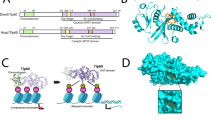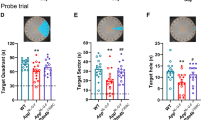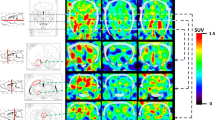Abstract
The targeting of two independent but synergistic enzymatic activities, histone deacetylases (HDACs, class I and HDAC6) and phosphodiesterase 5 (PDE5), has recently been validated as a potentially novel therapeutic approach for Alzheimer’s disease (AD). Here we report the discovery of a new first-in-class small-molecule (CM-414) that acts as a dual inhibitor of PDE5 and HDACs. We have used this compound as a chemical probe to validate this systems therapeutics strategy, where an increase in the activation of cAMP/cGMP-responsive element-binding protein (CREB) induced by PDE5 inhibition, combined with moderate HDAC class I inhibition, leads to efficient histone acetylation. This molecule rescued the impaired long-term potentiation evident in hippocampal slices from APP/PS1 mice. Chronic treatment of Tg2576 mice with CM-414 diminished brain Aβ and tau phosphorylation (pTau) levels, increased the inactive form of GSK3β, reverted the decrease in dendritic spine density on hippocampal neurons, and reversed their cognitive deficits, at least in part by inducing the expression of genes related to synaptic transmission. Thus, CM-414 may serve as the starting point to discover balanced dual inhibitors with an optimal efficacy and safety profile for clinical testing on AD patients.
Similar content being viewed by others
Log in or create a free account to read this content
Gain free access to this article, as well as selected content from this journal and more on nature.com
or
References
Bayer KU, Schulman H (2001). Regulation of signal transduction by protein targeting: the case for CaMKII. Biochem Biophys Res Commun 289: 917–923.
Benito E, Urbanke H, Ramachandran B, Barth J, Halder R, Awasthi A et al (2015). HDAC inhibitor-dependent transcriptome and memory reinstatement in cognitive decline models. J Clin Invest 125: 3572–3584.
Bliss TV, Collingridge GL (1993). A synaptic model of memory: long-term potentiation in the hippocampus. Nature 361: 31–39.
Borchelt DR, Thinakaran G, Eckman CB, Lee MK, Davenport F, Ratovitsky T et al (1996). Familial Alzheimer’s disease-linked presenilin 1 variants elevate Abeta1-42/1-40 ratio in vitro and in vivo. Neuron 17: 1005–1013.
Chiu CT, Wang Z, Hunsberger JG, Chuang DM (2013). Therapeutic potential of mood stabilizers lithium and valproic acid: beyond bipolar disorder. Pharmacol Rev 65: 105–142.
Cisse M, Halabisky B, Harris J, Devidze N, Dubal DB, Sun B et al (2011). Reversing EphB2 depletion rescues cognitive functions in Alzheimer model. Nature 469: 47–52.
Cook C, Gendron TF, Scheffel K, Carlomagno Y, Dunmore J, DeTure M et al (2012). Loss of HDAC6, a novel CHIP substrate, alleviates abnormal tau accumulation. Hum Mol Genet 21: 2936–2945.
Copeland RA, Basavapathruni A, Moyer M, Scott MP (2011). Impact of enzyme concentration and residence time on apparent activity recovery in jump dilution analysis. Anal Biochem 416: 206–210.
Cuadrado Tejedor M, Garcia Osta AM, Oyarzabal Santamarina J, Rabal Gracia MO, Novel hydroxamic acid compounds as dual inhibitors of phosphodiesterases and histone deacetylases. WO 2014/131855 A1, 2014.
Cuadrado-Tejedor M, Garcia-Barroso C, Sanzhez-Arias J, Mederos S, Rabal O, Ugarte A et al (2015). Concomitant histone deacetylase and phosphodiesterase 5 inhibition synergistically prevents the disruption in synaptic plasticity and it reverses cognitive impairment in a mouse model of Alzheimer’s disease. Clin Epigenetics 7: 108.
Cuadrado-Tejedor M, Garcia-Osta A, Ricobaraza A, Oyarzabal J, Franco R (2011a). Defining the mechanism of action of 4-phenylbutyrate to develop a small-molecule-based therapy for Alzheimer’s disease. Curr Med Chem 18: 5545–5553.
Cuadrado-Tejedor M, Hervias I, Ricobaraza A, Puerta E, Perez-Roldan JM, Garcia-Barroso C et al (2011b). Sildenafil restores cognitive function without affecting Ass burden in an Alzheimer’s disease mouse model. Br J Pharmacol 164: 2029–2041.
Cummings JL, Morstorf T, Zhong K (2014). Alzheimer’s disease drug-development pipeline: few candidates, frequent failures. Alzheimers Res Ther 6: 37.
Ding H, Dolan PJ, Johnson GV (2008). Histone deacetylase 6 interacts with the microtubule-associated protein tau. J Neurochem 106: 2119–2130.
Fischer A, Sananbenesi F, Wang X, Dobbin M, Tsai LH (2007). Recovery of learning and memory is associated with chromatin remodelling. Nature 447: 178–182.
Garcia-Barroso C, Ricobaraza A, Pascual-Lucas M, Unceta N, Rico AJ, Goicolea MA et al (2013). Tadalafil crosses the blood-brain barrier and reverses cognitive dysfunction in a mouse model of AD. Neuropharmacology 64: 114–123.
Garcia-Osta A, Cuadrado-Tejedor M (2016). Advanced assay monitoring APP-carboxyl-terminal fragments as markers of APP processing in Alzheimer disease mouse models. Methods Mol Biol 1303: 117–123.
Garcia-Osta A, Cuadrado-Tejedor M, Garcia-Barroso C, Oyarzabal J, Franco R (2012). Phosphodiesterases as therapeutic targets for Alzheimer’s disease. ACS Chem Neurosci 3: 832–844.
Gentleman VC, Dudoit S, Irizarry R, Huber W (eds). Bioinformatics and Computational Biology Solutions using R and Bioconductor. Springer: New York, NY; (2006).
Giese KP, Mizuno K (2013). The roles of protein kinases in learning and memory. Learn Mem 20: 540–552.
Glaser EM, Van der Loos H (1981). Analysis of thick brain sections by obverse-reverse computer microscopy: application of a new, high clarity Golgi-Nissl stain. J Neurosci Methods 4: 117–125.
Goguel V, Belair AL, Ayaz D, Lampin-Saint-Amaux A, Scaplehorn N, Hassan BA et al (2011). Drosophila amyloid precursor protein-like is required for long-term memory. J Neurosci 31: 1032–1037.
Gomez-Vallejo V, Ugarte A, Garcia-Barroso C, Cuadrado-Tejedor M, Szczupak B, Dopeso-Reyes IG et al (2016). Pharmacokinetic investigation of sildenafil using positron emission tomography and determination of its effect on cerebrospinal fluid cGMP levels. J Neurochem 136: 403–415.
Graff J, Rei D, Guan JS, Wang WY, Seo J, Hennig KM et al (2012). An epigenetic blockade of cognitive functions in the neurodegenerating brain. Nature 483: 222–226.
Guan JS, Haggarty SJ, Giacometti E, Dannenberg JH, Joseph N, Gao J et al (2009). HDAC2 negatively regulates memory formation and synaptic plasticity. Nature 459: 55–60.
Gurvich N, Tsygankova OM, Meinkoth JL, Klein PS (2004). Histone deacetylase is a target of valproic acid-mediated cellular differentiation. Cancer Res 64: 1079–1086.
Hsiao K, Chapman P, Nilsen S, Eckman C, Harigaya Y, Younkin S et al (1996). Correlative memory deficits, Abeta elevation, and amyloid plaques in transgenic mice. Science 274: 99–102.
Hubbert C, Guardiola A, Shao R, Kawaguchi Y, Ito A, Nixon A et al (2002). HDAC6 is a microtubule-associated deacetylase. Nature 417: 455–458.
Irizarry RA, Bolstad BM, Collin F, Cope LM, Hobbs B, Speed TP (2003). Summaries of Affymetrix GeneChip probe level data. Nucleic Acids Res 31: e15.
Kalin JH, Bergman JA (2013). Development and therapeutic implications of selective histone deacetylase 6 inhibitors. J Med Chem 56: 6297–6313.
Kazantsev AG, Thompson LM (2008). Therapeutic application of histone deacetylase inhibitors for central nervous system disorders. Nat Rev Drug Discov 7: 854–868.
Kilgore M, Miller CA, Fass DM, Hennig KM, Haggarty SJ, Sweatt JD et al (2010). Inhibitors of class 1 histone deacetylases reverse contextual memory deficits in a mouse model of Alzheimer’s disease. Neuropsychopharmacology 35: 870–880.
Langley B, D’Annibale MA, Suh K, Ayoub I, Tolhurst A, Bastan B et al (2008). Pulse inhibition of histone deacetylases induces complete resistance to oxidative death in cortical neurons without toxicity and reveals a role for cytoplasmic p21(waf1/cip1) in cell cycle-independent neuroprotection. J Neurosci 28: 163–176.
Langley B, Gensert JM, Beal MF, Ratan RR (2005). Remodeling chromatin and stress resistance in the central nervous system: histone deacetylase inhibitors as novel and broadly effective neuroprotective agents. Curr Drug Targets CNS Neurol Disord 4: 41–50.
Lauffer BE, Mintzer R, Fong R, Mukund S, Tam C, Zilberleyb I et al (2013). Histone deacetylase (HDAC) inhibitor kinetic rate constants correlate with cellular histone acetylation but not transcription and cell viability. J Biol Chem 288: 26926–26943.
Lehar J, Krueger AS, Avery W, Heilbut AM, Johansen LM, Price ER et al (2009). Synergistic drug combinations tend to improve therapeutically relevant selectivity. Nat Biotechnol 27: 659–666.
Lisman J, Schulman H, Cline H (2002). The molecular basis of CaMKII function in synaptic and behavioural memory. Nat Rev Neurosci 3: 175–190.
Lu YF, Hawkins RD (2002). Ryanodine receptors contribute to cGMP-induced late-phase LTP and CREB phosphorylation in the hippocampus. J Neurophysiol 88: 1270–1278.
Lu YF, Kandel ER, Hawkins RD (1999). Nitric oxide signaling contributes to late-phase LTP and CREB phosphorylation in the hippocampus. J Neurosci 19: 10250–10261.
Lucchesi W, Mizuno K, Giese KP (2011). Novel insights into CaMKII function and regulation during memory formation. Brain Res Bull 85: 2–8.
Manallack DT, Hughes RA, Thompson PE (2005). The next generation of phosphodiesterase inhibitors: structural clues to ligand and substrate selectivity of phosphodiesterases. J Med Chem 48: 3449–3462.
Mandelkow EM, Drewes G, Biernat J, Gustke N, Van Lint J, Vandenheede JR et al (1992). Glycogen synthase kinase-3 and the Alzheimer-like state of microtubule-associated protein tau. FEBS Lett 314: 315–321.
Mann BS, Johnson JR, Cohen MH, Justice R, Pazdur R (2007). FDA approval summary: vorinostat for treatment of advanced primary cutaneous T-cell lymphoma. Oncologist 12: 1247–1252.
McQuown SC, Barrett RM, Matheos DP, Post RJ, Rogge GA, Alenghat T et al (2011). HDAC3 is a critical negative regulator of long-term memory formation. J Neurosci 31: 764–774.
Miller TA, Witter DJ, Belvedere S (2003). Histone deacetylase inhibitors. J Med Chem 46: 5097–5116.
Puzzo D, Staniszewski A, Deng SX, Privitera L, Leznik E, Liu S et al (2009). Phosphodiesterase 5 inhibition improves synaptic function, memory, and amyloid-beta load in an Alzheimer’s disease mouse model. J Neurosci 29: 8075–8086.
Puzzo D, Vitolo O, Trinchese F, Jacob JP, Palmeri A, Arancio O (2005). Amyloid-beta peptide inhibits activation of the nitric oxide/cGMP/cAMP-responsive element-binding protein pathway during hippocampal synaptic plasticity. J Neurosci 25: 6887–6897.
Qing H, He G, Ly PT, Fox CJ, Staufenbiel M, Cai F et al (2008). Valproic acid inhibits Abeta production, neuritic plaque formation, and behavioral deficits in Alzheimer’s disease mouse models. J Exp Med 205: 2781–2789.
Reichenberg A, Mill J, MacCabe JH (2009). Epigenetics, genomic mutations and cognitive function. Cogn Neuropsychiatry 14: 377–390.
Ricobaraza A, Cuadrado-Tejedor M, Marco S, Perez-Otano I, Garcia-Osta A (2012). Phenylbutyrate rescues dendritic spine loss associated with memory deficits in a mouse model of Alzheimer disease. Hippocampus 22: 1040–1050.
Ricobaraza A, Cuadrado-Tejedor M, Perez-Mediavilla A, Frechilla D, Del Rio J, Garcia-Osta A (2009). Phenylbutyrate ameliorates cognitive deficit and reduces tau pathology in an Alzheimer’s disease mouse model. Neuropsychopharmacology 34: 1721–1732.
Robers MB, Dart ML, Woodroofe CC, Zimprich CA, Kirkland TA, Machleidt T et al (2015). Target engagement and drug residence time can be observed in living cells with BRET. Nat Commun 6: 10091.
Rumbaugh G, Sillivan SE, Ozkan ED, Rojas CS, Hubbs CR, Aceti M et al (2015). Pharmacological selectivity within class I histone deacetylases predicts effects on synaptic function and memory rescue. Neuropsychopharmacology 40: 2307–2316.
Sheng M, Greenberg ME (1990). The regulation and function of c-fos and other immediate early genes in the nervous system. Neuron 4: 477–485.
Smolen P, Baxter DA, Byrne JH (2014). Simulations suggest pharmacological methods for rescuing long-term potentiation. J Theor Biol 360: 243–250.
Smyth GK (2004). Linear models and empirical Bayes methods for assessing differential expression in microarray experiments. Stat Appl Genet Mol Biol 3: Article3.
Steinerman JR, Irizarry M, Scarmeas N, Raju S, Brandt J, Albert M et al (2008). Distinct pools of beta-amyloid in Alzheimer disease-affected brain: a clinicopathologic study. Arch Neurol 65: 906–912.
Subramanian A, Tamayo P, Mootha VK, Mukherjee S, Ebert BL, Gillette MA et al (2005). Gene set enrichment analysis: a knowledge-based approach for interpreting genome-wide expression profiles. Proc Natl Acad Sci USA 102: 15545–15550.
Sung YM, Lee T, Yoon H, Dibattista AM, Song JM, Sohn Y et al (2012). Mercaptoacetamide-based class II HDAC inhibitor lowers Abeta levels and improves learning and memory in a mouse model of Alzheimer’s disease. Exp Neurol 239C: 192–201.
Tzingounis AV, Nicoll RA (2006). Arc/Arg3.1: linking gene expression to synaptic plasticity and memory. Neuron 52: 403–407.
Ugarte A, Gil-Bea F, Garcia-Barroso C, Cedazo-Minguez A, Ramirez MJ, Franco R et al (2015). Decreased levels of cGMP in CSF are associated with cognitive decline and amyloid pathology in Alzheimer’s disease. Neuropathol Appl Neurobiol 41: 471–482.
Vaillant AR, Zanassi P, Walsh GS, Aumont A, Alonso A, Miller FD (2002). Signaling mechanisms underlying reversible, activity-dependent dendrite formation. Neuron 34: 985–998.
Weyer SW, Klevanski M, Delekate A, Voikar V, Aydin D, Hick M et al (2011). APP and APLP2 are essential at PNS and CNS synapses for transmission, spatial learning and LTP. EMBO J 30: 2266–2280.
Yu CW, Chang PT, Hsin LW, Chern JW (2013). Quinazolin-4-one derivatives as selective histone deacetylase-6 inhibitors for the treatment of Alzheimer’s disease. J Med Chem 56: 6775–6791.
Zhang KY, Card GL, Suzuki Y, Artis DR, Fong D, Gillette S et al (2004). A glutamine switch mechanism for nucleotide selectivity by phosphodiesterases. Mol Cell 15: 279–286.
Zhang L, Liu C, Wu J, Tao JJ, Sui XL, Yao ZG et al (2014). Tubastatin A/ACY-1215 improves cognition in Alzheimer’s disease transgenic mice. J Alzheimers Dis 41: 1193–1205.
Zhang ZY, Schluesener HJ (2013). Oral administration of histone deacetylase inhibitor MS-275 ameliorates neuroinflammation and cerebral amyloidosis and improves behavior in a mouse model. J Neuropathol Exp Neurol 72: 178–185.
Zheng H, Fridkin M, Youdim M (2014). From single target to multitarget/network therapeutics in Alzheimer’s therapy. Pharmaceuticals (Basel) 7: 113–135.
Zheng H, Fridkin M, Youdim M (2015). New approaches to treating Alzheimer's disease. Perspect Medicin Chem 7: 1–8.
Acknowledgements
We thank Maria Espelosin and Susana Ursua for their work in the animal facility and cell culture.
Author information
Authors and Affiliations
Corresponding authors
Additional information
Supplementary Information accompanies the paper on the Neuropsychopharmacology website
Supplementary information
Rights and permissions
About this article
Cite this article
Cuadrado-Tejedor, M., Garcia-Barroso, C., Sánchez-Arias, J. et al. A First-in-Class Small-Molecule that Acts as a Dual Inhibitor of HDAC and PDE5 and that Rescues Hippocampal Synaptic Impairment in Alzheimer’s Disease Mice. Neuropsychopharmacol 42, 524–539 (2017). https://doi.org/10.1038/npp.2016.163
Received:
Revised:
Accepted:
Published:
Issue date:
DOI: https://doi.org/10.1038/npp.2016.163
This article is cited by
-
Sleep patterns, plasma metabolites, and risk of incident osteoarthritis: a prospective cohort study
Scientific Reports (2025)
-
Polycyclitol Derivatives Restore Long- Term Memory Via cdk5/p25 Activation of Tau Signaling in Experimental Cerebral Malaria
Neurochemical Research (2025)
-
Small molecule modulators of chromatin remodeling: from neurodevelopment to neurodegeneration
Cell & Bioscience (2023)
-
[11C]Martinostat PET analysis reveals reduced HDAC I availability in Alzheimer’s disease
Nature Communications (2022)
-
HDAC inhibition ameliorates cone survival in retinitis pigmentosa mice
Cell Death & Differentiation (2021)



